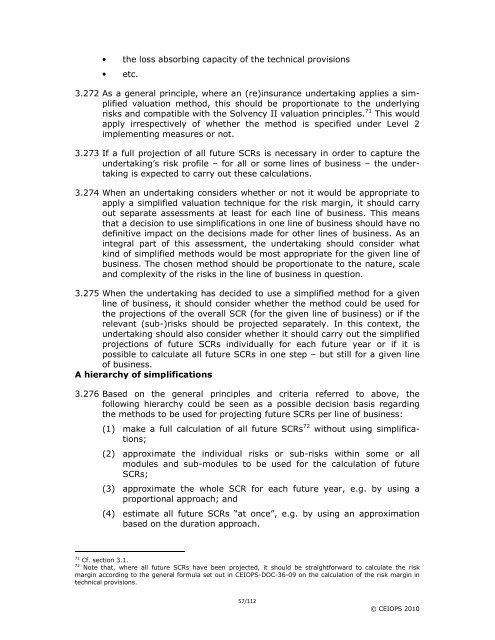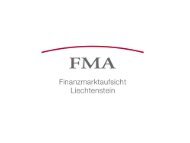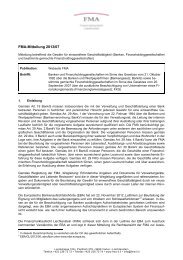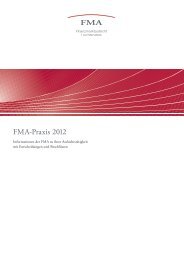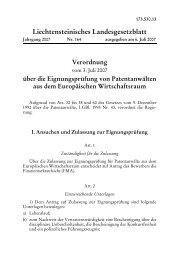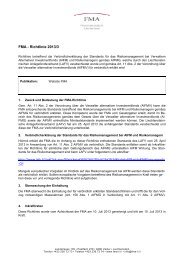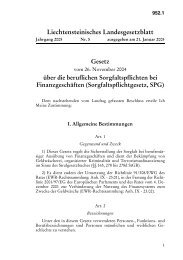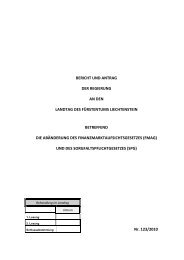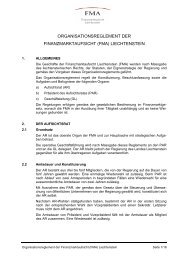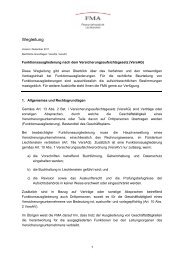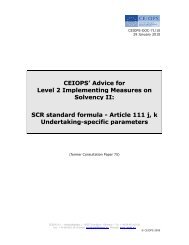CEIOPS' Advice for Level 2 Implementing ... - EIOPA - Europa
CEIOPS' Advice for Level 2 Implementing ... - EIOPA - Europa
CEIOPS' Advice for Level 2 Implementing ... - EIOPA - Europa
You also want an ePaper? Increase the reach of your titles
YUMPU automatically turns print PDFs into web optimized ePapers that Google loves.
• the loss absorbing capacity of the technical provisions<br />
• etc.<br />
3.272 As a general principle, where an (re)insurance undertaking applies a simplified<br />
valuation method, this should be proportionate to the underlying<br />
risks and compatible with the Solvency II valuation principles. 71 This would<br />
apply irrespectively of whether the method is specified under <strong>Level</strong> 2<br />
implementing measures or not.<br />
3.273 If a full projection of all future SCRs is necessary in order to capture the<br />
undertaking’s risk profile – <strong>for</strong> all or some lines of business – the undertaking<br />
is expected to carry out these calculations.<br />
3.274 When an undertaking considers whether or not it would be appropriate to<br />
apply a simplified valuation technique <strong>for</strong> the risk margin, it should carry<br />
out separate assessments at least <strong>for</strong> each line of business. This means<br />
that a decision to use simplifications in one line of business should have no<br />
definitive impact on the decisions made <strong>for</strong> other lines of business. As an<br />
integral part of this assessment, the undertaking should consider what<br />
kind of simplified methods would be most appropriate <strong>for</strong> the given line of<br />
business. The chosen method should be proportionate to the nature, scale<br />
and complexity of the risks in the line of business in question.<br />
3.275 When the undertaking has decided to use a simplified method <strong>for</strong> a given<br />
line of business, it should consider whether the method could be used <strong>for</strong><br />
the projections of the overall SCR (<strong>for</strong> the given line of business) or if the<br />
relevant (sub-)risks should be projected separately. In this context, the<br />
undertaking should also consider whether it should carry out the simplified<br />
projections of future SCRs individually <strong>for</strong> each future year or if it is<br />
possible to calculate all future SCRs in one step – but still <strong>for</strong> a given line<br />
of business.<br />
A hierarchy of simplifications<br />
3.276 Based on the general principles and criteria referred to above, the<br />
following hierarchy could be seen as a possible decision basis regarding<br />
the methods to be used <strong>for</strong> projecting future SCRs per line of business:<br />
(1) make a full calculation of all future SCRs 72 without using simplifications;<br />
(2) approximate the individual risks or sub-risks within some or all<br />
modules and sub-modules to be used <strong>for</strong> the calculation of future<br />
SCRs;<br />
(3) approximate the whole SCR <strong>for</strong> each future year, e.g. by using a<br />
proportional approach; and<br />
(4) estimate all future SCRs “at once”, e.g. by using an approximation<br />
based on the duration approach.<br />
71 Cf. section 3.1.<br />
72 Note that, where all future SCRs have been projected, it should be straight<strong>for</strong>ward to calculate the risk<br />
margin according to the general <strong>for</strong>mula set out in CEIOPS-DOC-36-09 on the calculation of the risk margin in<br />
technical provisions.<br />
57/112<br />
© CEIOPS 2010


